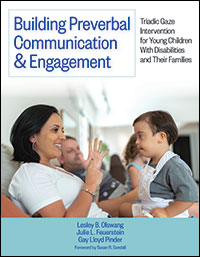 Today we’re excited to welcome the authors of an important guidebook for a wide range of early childhood professionals, including early interventionists, SLPs, occupational therapists, physical and therapists. Lesley B. Olswang, Julie Feuerstein, and Gay Lloyd Pinder are here to talk about Building Preverbal Communication & Engagement—why and how they developed this groundbreaking resource on Triadic Gaze Intervention, and how it benefits young children with disabilities and their families. Read on for a great introduction to this must-have book!
Today we’re excited to welcome the authors of an important guidebook for a wide range of early childhood professionals, including early interventionists, SLPs, occupational therapists, physical and therapists. Lesley B. Olswang, Julie Feuerstein, and Gay Lloyd Pinder are here to talk about Building Preverbal Communication & Engagement—why and how they developed this groundbreaking resource on Triadic Gaze Intervention, and how it benefits young children with disabilities and their families. Read on for a great introduction to this must-have book!
Let’s start with some background information. To orient readers who may be new to this terminology: what is triadic gaze?
Triadic gaze is an exciting milestone in communication development that occurs in the first year of a child’s life, long before first words emerge. Early in life, children primarily look at interesting objects or adults, but not both. Around 9-10 months of age, children begin to look back and forth between objects and people they are interested in. This remarkable transition toward using a three-point gaze shift (object-person-object, person-object-person) reflects a thrilling development in communication and cognitive skills! By producing this triadic gaze, children are now showing their ability to link people and objects in their world.
Typically, children will use triadic gaze first to get something they want (e.g., truck, please!) or to ask for something fun to continue (e.g., blow the bubbles again!). This behavior has been interpreted as a hallmark of intentional communication, and the beginnings of a beautiful dance between a child and their communication partner. Often, children with typical development will include vocalizations and/or early gestures (reaching, pointing) along with their back-and-forth looking as they communicate and engage with adults.
For many children, triadic gaze may be the first signal of communication addressed by their speech-language pathologist or other early intervention providers. When included in a child’s Individualized Family Service Plan (IFSP), triadic gaze can be a behavior easily addressed across a range of family routines and activities.
Your book focuses on Triadic Gaze Intervention. What is TGI, and how does it support the development of early communication behaviors like gaze, gestures, and vocalizations in young children with disabilities?
Young children with disabilities, particularly those with motor impairments, may have trouble producing clear behaviors of engagement and communication with others. Shifts in eye gaze, clear vocalizations, and early gestures can be particularly difficult to produce and to recognize. TGI is a strategy to help overcome these challenges.
TGI helps families engage and communicate with their young children with disabilities by teaching children to use eye gaze as a consistent, clear behavior. It helps families recognize and respond to these early communication signals. And it guides families to structure their environment for the purpose of teaching their children to consistently use eye gaze—along with gestures and vocalizations—to request and comment about objects and events in their world.
Your book introduces a specific protocol called PoWRRS-Connect for implementing TGI effectively with families. How did you develop the protocol, and can you give a brief overview of it?
The TGI protocol offers families a way to build communication opportunities into their everyday routines and activities. Within these moments, EI providers can coach families to support their children’s learning of triadic gaze as a clear and intentional signal of communication. The protocol consists of six steps that mirror a typical back-and-forth routine between a child and their communication partner. This protocol was developed and researched over approximately two decades at the University of Washington in collaboration with several birth-to-three community centers in the Seattle area.
The protocol is called “PoWRRS-Connect,” an acronym for these six elements:
- Po: Provide an opportunity for the child to communicate
- W: Wait for the child to respond
- R: Recognize the child’s attempt at communication, whatever it may be
- R: Respond to the child’s attempt
- S: Shape the child’s behavior into a more readable signal of communication (ultimately, triadic gaze)
- Connect: Connect with the child through play and engagement. Remember, this should be fun for both the child and the adult communication partner!
These six steps should feel natural and easy to follow. They can be integrated into a variety of routines and activities without any extra supplies or special skills. EI providers from a variety of professional backgrounds (e.g., SLP, OT, PT, and other EI specialists) can support families in learning to use the six steps with their children as they play and engage at home or in their communities.
Your book includes guidance on how to implement PoWRRS-Connect with families during everyday routines. In your work with families, have you found that they readily adapt to using PoWRRS-Connect? What do families seem to like most about this approach?
Families have embraced this intervention because it allows them to successfully engage and communicate with their young children with disabilities. PoWRRS-Connect prioritizes early connections between children and their families—connecting and engaging are at the heart of this approach!
Children with moderate to severe motor impairments often produce behaviors that are hard to interpret, and the connection between children and their caregivers can get broken. The structure of PoWRRS-Connect supports families in re-establishing this connection. Families have appreciated the emphasis on gaze as communication.
Families also report finding the PoWRRS-Connect protocol adaptable to their daily activities. The six steps provide a clear structure for the typical back-and-forth interaction between children and their adult communication partners. Most importantly, the structure is easily implemented because it is short and reflects natural communication turns. Our book contains a chapter with observations from families about their use of PoWRRS-Connect and their thoughts about TGI as it supported their children’s communication development.
Since every child and family is unique, how does the PoWRRS-Connect protocol accommodate the different styles, preferences, and circumstances among families?
The PoWRRS-Connect protocol was designed to be implemented in the context of each family’s daily routines and activities. PoWRRS-Connect helps the family or EI practitioner identify what to focus on to support engagement and communication, but not when to do so. When a family chooses to use PoWRRS-Connect and how they integrate it into daily interactions with their child can (and should!) look different across families.
Family routines, resources, preferences, priorities, and individual characteristics vary widely, and PoWRRS-Connect can be responsive to these variations across families and children. Some families may readily identify the daily routines and activities in which PoWRRS-Connect can work; others may need help to identify those moments. Some families may have limited toys or opportunities to play with their children. That’s fine, as moments for connection and engagement can be found with any objects and any daily routine!
Chapter 8 of our book provides tips to providers and families about ways to tailor PoWRRS-Connect to meet individual needs, styles, and preferences. Table 8.1 offers ideas for embedding communication opportunities and implementing PoWRRS-Connect into a range of routines and activities across a family’s day.
When Triadic Gaze Intervention is being used with a family, how is a child’s progress typically monitored? How does a practitioner collect evidence that it’s working?
TGI offers a developmentally appropriate approach to capturing the often slow, incremental changes that occur in early communication development for children with disabilities. Specifically, TGI offers a practical way to identify observable behaviors (gaze, gestures, vocalizations) along a continuum of communication skills (from single to dual to triadic focus), that children produce as they shift from preintentional to intentional communication.
These subtle changes in communication often are difficult to capture with more global assessments of communication. The Checklist of Early Communication Behaviors, included in the book, provides practitioners and caregivers with a practical tool for monitoring a child’s progress along the communication continuum across three dimensions:
- consistency of a child’s communication behaviors (from intermittent to consistent)
- sophistication of a child’s communication behaviors (from simple to more complex)
- independence of their productions (from dependent on adult support to independent initiations)
Can you talk a little about the online downloads you developed to accompany the book—including the caregiver handouts and demonstration videos? How will these materials help readers put PoWRRS-Connect into action?
Two types of downloads accompany the book: video examples and caregiver handouts.
Videos have been found useful in demonstrating how the PoWRRS-Connect protocol can be administered to children with different motor or cognitive challenges or temperament styles. Over the 30 years of PoWRRS-Connect research, children and families with varying needs have been involved. Videos have come from the actual delivery of the intervention with these individuals, providing a rich resource of examples to illustrate the intervention’s versatility.
To facilitate family use of PoWRRS-Connect, we provide an easy-to-read handout to serve as a reminder of the six elements and how to deliver them. These caregiver handouts are available in both English and Spanish.
If PoWRRS-Connect was used with every family who could benefit from it, what would the ultimate impact be for children with disabilities and their families?
The most exciting skill and the one that separates human beings from other life forms on this planet is communication—specifically, symbolic communication. Communication is connection. Communication is power. Communication brings people together to share, to create, and to care for each other. When the ability to communicate is blocked for whatever reason, that person is isolated and DIS-abled in a tragic way.
For children and families for whom TGI is appropriate, PoWRRS-Connect is a tool to support the development of active and intentional communication. Families would recognize and have an appreciation of their child as an active communication partner, one who is able to respond, able to make their own choices, and even choose the topic of conversation! The interminable 20-questions game would no longer be the only way to discern what the child wants.
Knowing how to use their eyes to engage and direct their communication partner gives children the experience of communicating their wants and needs independently, and not always being “done to,” taken care of, or stuck in the role of being dependent on others. The early experience of being an independent communicator builds self confidence in the child and enables others to see the child as an active communication partner with their own desires, interests, and goals. Ultimately, the early positive communication experience and practice lays the foundation for the shift from presymbolic to symbolic communication, opening the door to developing reading and writing skills.
Thanks to the authors of Building Preverbal Communication & Engagement for visiting our blog and offering an in-depth guide to the why and how of TGI and its protocol, PoWRRS-Connect. To harness the power of this approach in your program, add the book to your professional library today!

Building Preverbal Communication & Engagement
Triadic Gaze Intervention for Young Children With Disabilities and Their Families
By Lesley B. Olswang, Ph.D., CCC-SLP, Julie Feuerstein, Ph.D., CCC-SLP, & Gay Lloyd Pinder, Ph.D., CCC-SLP, C/NDT
“Wonderful and much-needed…This gem provides a wealth of strategies and resources for coaching families in order to help them foster skills during naturally occurring routines that lay the often-overlooked foundation for intentional communication.”—Merle Crawford, Board Certified Behavior Analyst, co-author of Early Intervention Every Day
“Essential reading for any provider who works with children who communicate with preverbal behaviors…an evidence-based, practical and inspiring guide.”—Gay Burton, Program Director, Boyer Children’s Clinic
Stay up to date on the latest posts, news, strategies, and more!
Sign up for one of our FREE newslettersMore posts like this
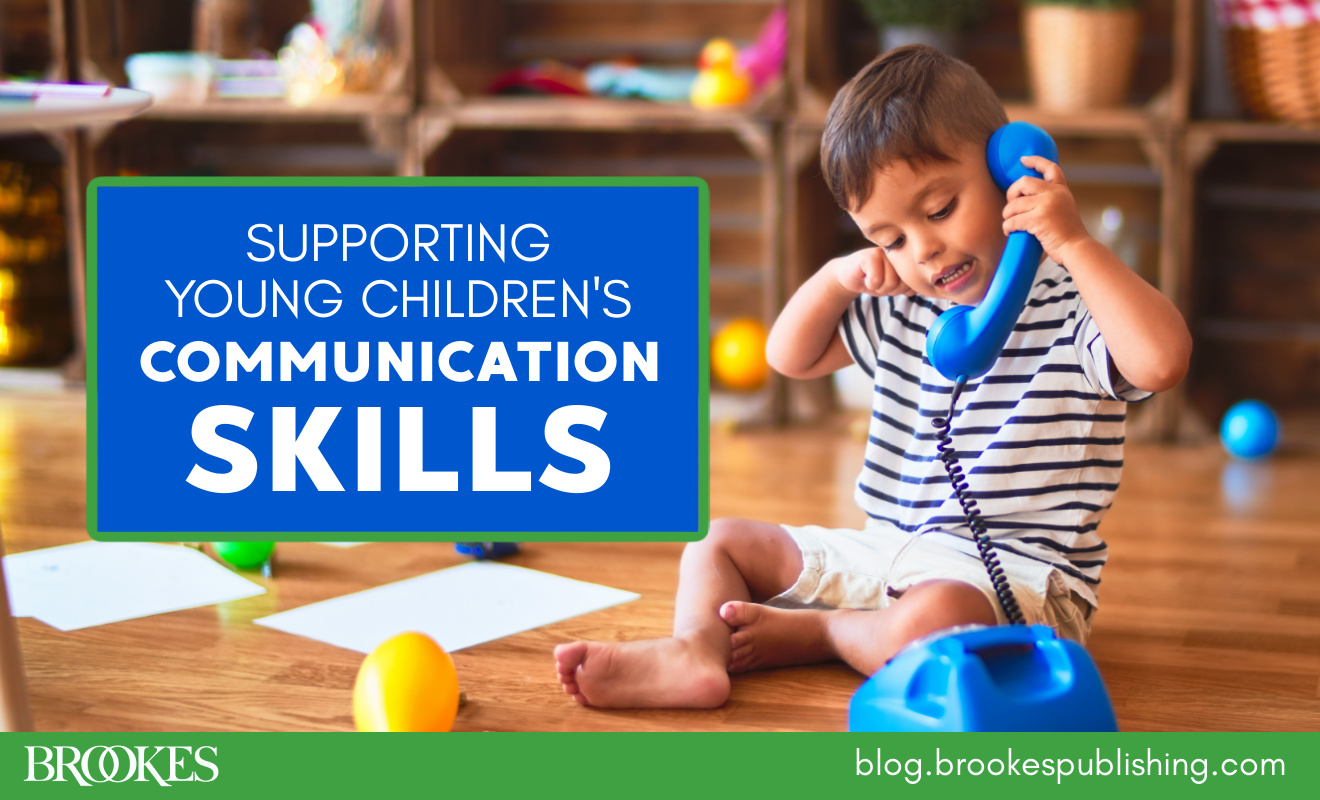
10 Easy Ways to Support a Young Child’s Communication Skills
January 11, 2024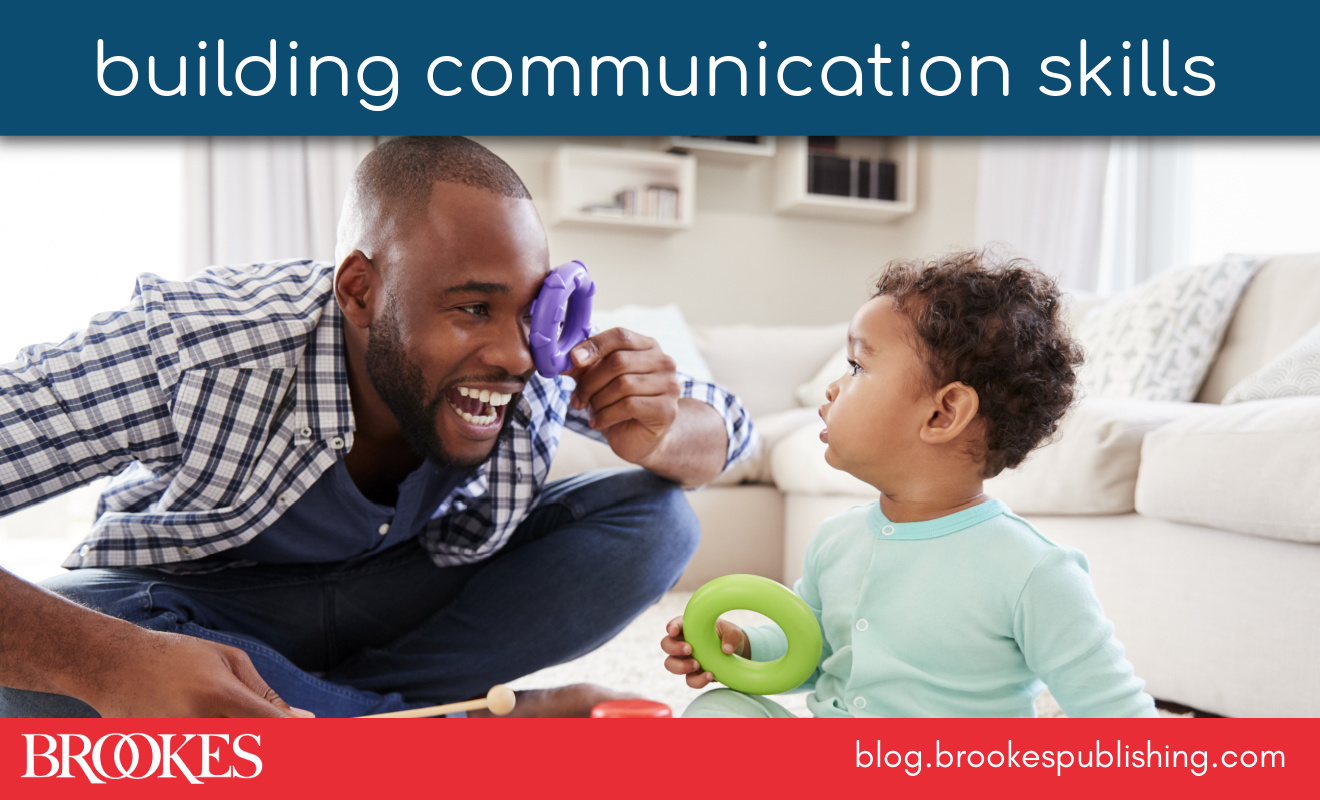
14 Tips for Nurturing Young Children’s Communication & Language Skills
December 9, 2021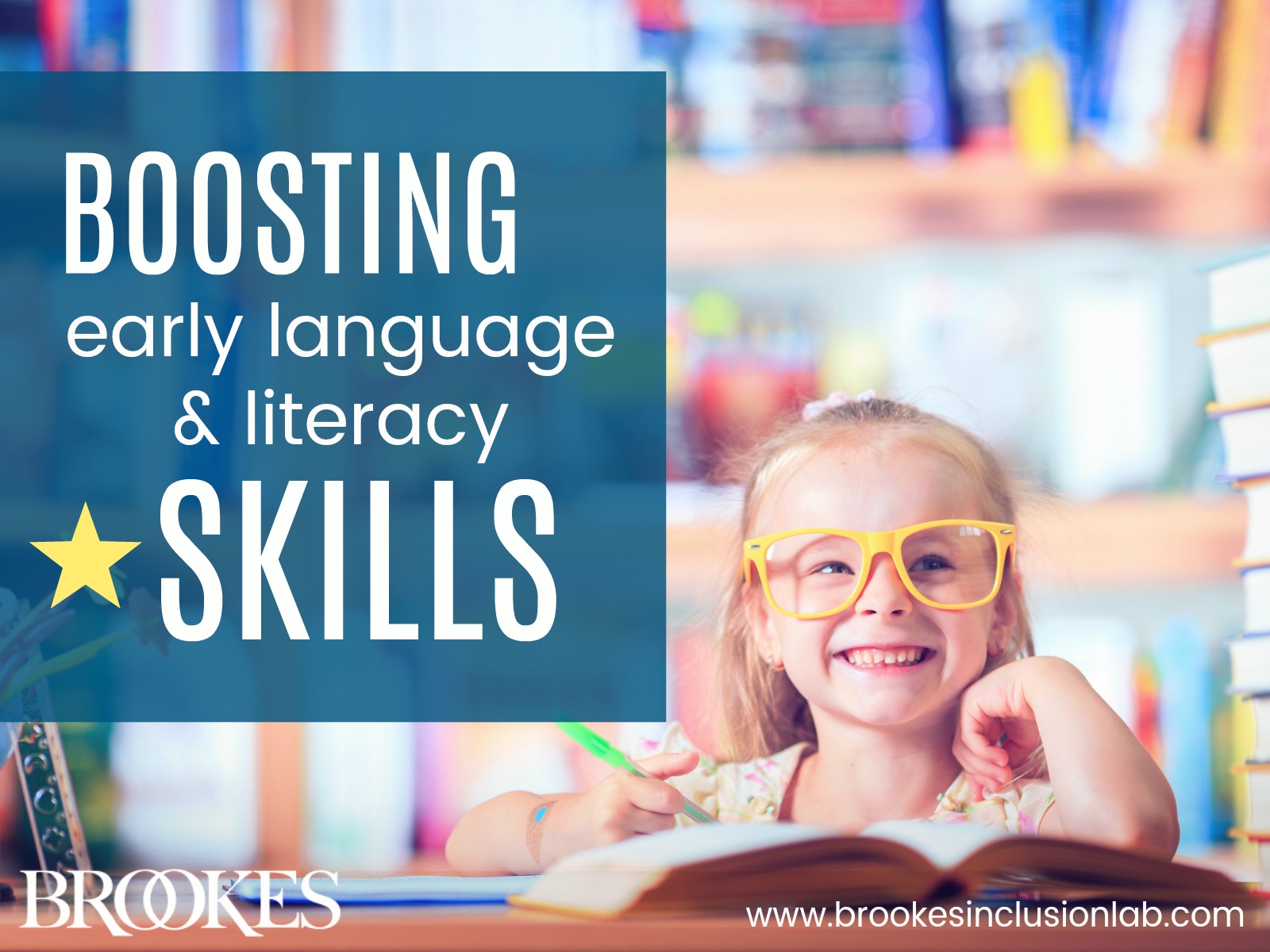

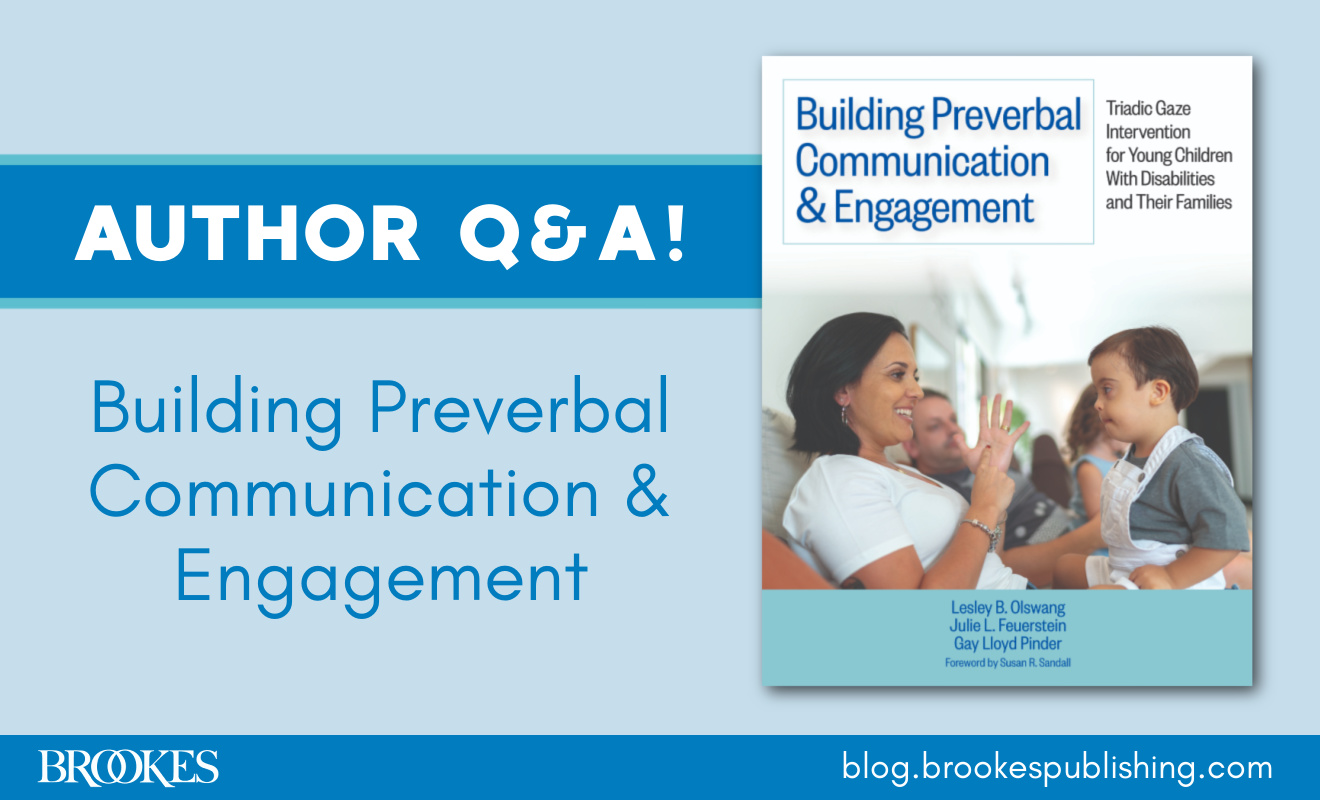
Write a Comment
Your email address will not be published. Required fields are marked *
Post a Comment